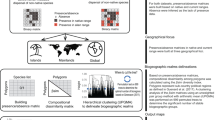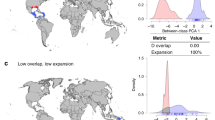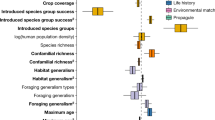Abstract
Human trade and travel are breaking down biogeographic barriers, resulting in shifts in the geographical distribution of organisms, yet it remains largely unknown whether different alien species generally follow similar spatiotemporal colonization patterns and how such patterns are driven by trends in global trade. Here, we analyse the global distribution of 241 alien ant species and show that these species comprise four distinct groups that inherently differ in their worldwide distribution from that of native species. The global spread of these four distinct species groups has been greatly, but differentially, influenced by major events in recent human history, in particular historical waves of globalization (approximately 1850–1914 and 1960 to present), world wars and global recessions. Species in these four groups also differ in six important morphological and life-history traits and their degree of invasiveness. Combining spatiotemporal distribution data with life-history trait information provides valuable insight into the processes driving biological invasions and facilitates identification of species most likely to become invasive in the future.
This is a preview of subscription content, access via your institution
Access options
Access Nature and 54 other Nature Portfolio journals
Get Nature+, our best-value online-access subscription
$29.99 / 30 days
cancel any time
Subscribe to this journal
Receive 12 digital issues and online access to articles
$119.00 per year
only $9.92 per issue
Buy this article
- Purchase on Springer Link
- Instant access to full article PDF
Prices may be subject to local taxes which are calculated during checkout




Similar content being viewed by others
References
Capinha, C., Essl, F., Seebens, H., Moser, D. & Pereira, H. M. The dispersal of alien species redefines biogeography in the Anthropocene. Science 348, 1248–1251 (2015).
Corlett, R. T. The Anthropocene concept in ecology and conservation. Trends Ecol. Evol. 30, 36–41 (2015).
Simberloff, D. et al. Impacts of biological invasions — what’s what and the way forward. Trends Ecol. Evol. 28, 58–66 (2013).
Essl, F. et al. Socioeconomic legacy yields an invasion debt. Proc. Natl Acad. Sci. USA 108, 203–207 (2011).
Hulme, P. E. Trade, transport and trouble: managing invasive species pathways in an era of globalization. J. Appl. Ecol. 46, 10–18 (2009).
Ascunce, M. S. et al. Global invasion history of the fire ant Solenopsis invicta. Science 331, 1066–1068 (2011).
Van Kleunen, M. et al. Global exchange and accumulation of non-native plants. Nature 525, 100–103 (2015).
Pyšek, P. et al. Disentangling the role of environmental and human pressures on biological invasions across Europe. Proc. Natl Acad. Sci. USA 107, 12157–12162 (2010).
Westphal, M. I., Browne, M., MacKinnon, K. & Noble, I. The link between international trade and the global distribution of invasive alien species. Biol. Invasions 10, 391–398 (2008).
Hölldobler, B. & Wilson, E. The Ants (Harvard Univ. Press, 1990).
Suarez, A. V., Holway, D. A. & Case, T. J. Patterns of spread in biological invasions dominated by long-distance jump dispersal: insights from Argentine ants. Proc. Natl Acad. Sci. USA 98, 1095–1100 (2001).
Rabitsch, W. The hitchhiker’s guide to alien ant invasions. BioControl 56, 551–572 (2011).
Holway, D. A. et al. The causes and consequences of ant invasions. Annu. Rev. Ecol. Syst. 33, 181–233 (2002).
Sanders, N. J., Gotelli, N. J., Heller, N. E. & Gordon, D. M. Community disassembly by an invasive species. Proc. Natl Acad. Sci. USA 100, 2474–2477 (2003).
Passera, L. in Exotic Ants: Biology, Impact and Control of Introduced Species (ed. Williams, D. ) 23–43 (Westview, 1994).
Rao, C. Diversity and dissimilarity coefficients: a unified approach. Theor. Popul. Biol. 21, 24–43 (1982).
World Trade Report 2014 (World Trade Organization, 2014).
Baldwin, R. & Martin, P. Two Waves of Globalisation: Superficial Similarities, Fundamental Differences (National Bureau of Economic Research, 1999).
Cazelles, B. et al. Wavelet analysis of ecological time series. Oecologia 156, 287–304 (2008).
Seebens, H. et al. No saturation in the accumulation of alien species worldwide. Nat. Commun. 8, 14435 (2017).
Arim, M., Abades, S. R., Neill, P. E., Lima, M. & Marquet, P. A. Spread dynamics of invasive species. Proc. Natl Acad. Sci. USA 103, 374–378 (2006).
Jeschke, J. M. & Strayer, D. L. Invasion success of vertebrates in Europe and North America. Proc. Natl Acad. Sci. USA 102, 7198–7202 (2005).
Banks, N. C., Paini, D. R., Bayliss, K. L. & Hodda, M. The role of global trade and transport network topology in the human-mediated dispersal of alien species. Ecol. Lett. 18, 188–199 (2015).
Liebhold, A. M., Brockerhoff, E. G., Garrett, L. J., Parke, J. L. & Britton, K. O. Live plant imports: the major pathway for forest insect and pathogen invasions of the US. Front. Ecol. Environ. 10, 135–143 (2012).
Levine, J. M. & D’Antonio, C. M. Forecasting biological invasions with increasing international trade. Conserv. Biol. 17, 322–326 (2003).
Bertelsmeier, C., Luque, G. M., Confais, A. & Courchamp, F. Ant Profiler — a database of ecological characteristics of ants (Hymenoptera: Formicidae). Myrmecol. News 18, 73–76 (2013).
McGlynn, T. P. Non-native ants are smaller than related native ants. Am. Nat. 154, 690–699 (1999).
Pitt, J. P. W., Worner, S. P. & Suarez, A. V. Predicting Argentine ant spread over the heterogeneous landscape using a spatially explicit stochastic model. Ecol. Appl. 19, 1176–1186 (2012).
Hayes, K. R. & Barry, S. C. Are there any consistent predictors of invasion success? Biol. Invasions 10, 483–506 (2008).
Carboni, M. et al. What it takes to invade grassland ecosystems: traits, introduction history and filtering processes. Ecol. Lett. 19, 219–229 (2015).
Sol, D. et al. Unraveling the life history of successful invaders. Science 337, 580–583 (2012).
Allen, W. L., Street, S. E. & Capellini, I. Fast life history traits promote invasion success in amphibians and reptiles. Ecol. Lett. 20, 220–230 (2017).
Davis, M. Invasion Biology (Oxford Univ. Press, 2009).
Dyer, E. E. et al. The global distribution and drivers of alien bird species introduction and richness. PLoS Biol. 15, 942–942 (2017).
Roques, A. et al. Temporal and interspecific variation in rates of spread for insect species invading Europe during the last 200 years. Biol. Invasions 18, 907–920 (2016).
Brenton-Rule, E. C. et al. Corruption, development and governance indicators predict invasive species risk from trade. Proc. Biol. Sci. 283, 20160901 (2016).
Rouget, M. et al. Invasion debt — quantifying future biological invasions. Divers. Distrib. 22, 445–456 (2015).
Wittenborn, D. & Jeschke, J. M. Characteristics of exotic ants in North America. NeoBiota 64, 47–64 (2011).
McGlynn, T. P. The worldwide transfer of ants: geographical distribution and ecological invasions. J. Biogeogr. 26, 535–548 (1999).
Bolton, B ., Alpert, G ., Ward, P. S & Naskrecki, P. Bolton’s Catalogue of the Ants of the World (Harvard Univ. Press, 2007).
Ward, D. F., Rees, J., Harris, R. J. & Stanley, M. C. New Zealand Ant Distribution Database v.2.0 (Landcare Research, 2016); http://www.landcareresearch.co.nz/research/biocons/invertebrates/ants/distribution
Deyrup, M., Davis, L. & Cover, S. Exotic ants in Florida. Trans. Am. Entomol. Soc. 126, 293–326 (2000).
Martin, P., Mayer, T. & Thoenig, M. Make trade not war? Rev. Econ. Stud. 75, 865–900 (2008).
Audigier, V., Husson, F. & Josse, J. A principal component method to impute missing values for mixed data. Adv. Data Anal. Classif. 10, 5–26 (2016).
Sinnott, R. Virtues of the haversine. Sky Telescope 68, 159 (1984).
Hennig, C. Cluster-wise assessment of cluster stability. Comput. Stat. Data Anal. 52, 258–271 (2007).
R: A language and environment for statistical computing v.3.1.1 (R Foundation for Statistical Computing, 2014).
Acknowledgements
We thank M. Chapuisat, P. Christe, P. Lester, J. Pannell, J. Søe Pedersen, I. Sanders and C. Wedekind for their comments, and A. Suarez, E. Robinson and J. Longino for supplying data on morphological and life-history traits. This work was supported by several grants from the Swiss National Science Foundation and a European Research Council advanced grant. Data reported in the paper are presented in the Supplementary materials.
Author information
Authors and Affiliations
Contributions
C.B. and L.K. designed the study, C.B. and A.L. collected the data, C.B. and S.O. analysed the data and all authors discussed the analyses and wrote the paper.
Corresponding authors
Ethics declarations
Competing interests
The authors declare no competing financial interests.
Supplementary information
Supplementary Information
Four Supplementary Figures, two Supplementary Tables, and Supplementary Notes detailing the calculation of historical transition rates among dispersion stages (PDF 22540 kb)
Supplementary Dataset 1
An R object containing all data used in analyses. (ZIP 1808 kb)
Supplementary Dataset 2
An R script with code for all analyses and figures. (ZIP 9 kb)
Rights and permissions
About this article
Cite this article
Bertelsmeier, C., Ollier, S., Liebhold, A. et al. Recent human history governs global ant invasion dynamics. Nat Ecol Evol 1, 0184 (2017). https://doi.org/10.1038/s41559-017-0184
Received:
Accepted:
Published:
DOI: https://doi.org/10.1038/s41559-017-0184
This article is cited by
-
Detection and early impacts of France’s first established population of the little fire ant, Wasmannia auropunctata
Biological Invasions (2024)
-
Gut microbiota in parasite-transmitting gastropods
Infectious Diseases of Poverty (2023)
-
Behavioral assays reveal mechanisms of supercolony formation in odorous house ants
Scientific Reports (2023)
-
Evolutionary imbalance, climate and human history jointly shape the global biogeography of alien plants
Nature Ecology & Evolution (2023)
-
Prevalence and drivers of a tree-killing bark beetle, Ips typographus (Coleoptera, Scolytinae), in international invasion pathways into the USA
Journal of Pest Science (2023)



